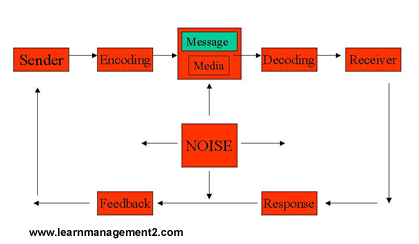|

For management learners globally
Home | Management Concepts | Newsletter | About | Contact | PowerPoints | Management Cliparts |
COMMUNICATION THEORY - Page 1 of 2
Organisations can not operate without communication. Communication can take various forms but all forms involve the transfer of information from one party to the other. In order for the transfer of information to qualify as communication, the recipient must understand the meaning of the information transferred to them. If the recipient does not understand the meaning of the information conveyed to them, communication has not taken place.
Communication is the life source of organisations because organisations involve people. People cannot interact with each other without communication. In the absence of communication, everything would grind to a halt. For example;
The workers in an organisation would not know the organisation’s objectives so they would not strive to achieve the organisation’s objectives.
-
The workers in an organisation would not know what their roles and responsibilities were, so they would not be able to carry out their daily tasks and duties.
-
The managers would not be able to train their workers reports so the workers would not possess the skills they needed to carry out their jobs.
-
The managers would not be able to inform workers of changes
-
The organisation would not be aware of their competitors activities
And the list is endless……………..
On the whole people are able to communicate with each other as this is a basic human function. However successful organisations strive not only for communication but effective communication.
Interpersonal Communication
This is defined as communication between two or more people and involves the transfer of information (or message) from one person to the other(s). The person transferring the information is called the sender or transmitter. The people receiving the message are known as receivers. The transmitter will need to send the information in a format that the receiver(s) will understand. Converting the information into a format that the receivers will understand is known as Encoding.
Messages can be encoded into a variety of formats oral, written or visual. After encoding the message is transferred via a medium called a channel, for example a letter, fax, phone call, or e-mail. After transference the information will need to be interpreted by the receiver. This process of interpretation is known as decoding. Finally the receiver will send a message back to the transmitter confirming whether the information sent has been understood. This back check is known as feedback.
The communication process involves seven key elements as illustrated in the diagram below.

Barriers to effective Communication (leaky bucket)
At each stage in the process encoding, transference, and decoding there is the possibility of interference which may hinder the communication process. This interference is known as noise. Often a comparison is made between communication and a leaky bucket. If you use a leaky bucket to carry water, water will be lost at various points in your journey from the water tap to your destination. It is not possible to stop losing water because the bucket contains holes. The amount of water you will lose will be determined by the number of holes in the bucket, the size of the holes, the route you take to your final destination and length of time it takes you to get to your destination. There may also be other events that occur during your journey which increase the amount of water lost.Similarly when information is transferred from the transmitter to the receiver not all of the information may be received by the receiver because of holes called noise. Each of the noise may be affect the amount of information transferred. Just as in a leaky bucket, more holes decrease the amount of water, more noise decreases the amount of correct information received. Noise can take a variety of forms including
Language issues and Cultural Differences : the receiver(s) may not (fully) understand the language used by the transmitter. This may occur if the transmitter’s language is foreign to the receiver. There may also be language problems (that the communication process) if the message contains technical information and the receiver’s is not familiar with the technical terms used. Cultural differences created by an individual’s background and experience affect their perception of the world. Such cultural differences may affect the interpretation (decoding) of the message sent.
Environmental issues: If the environment that the transmitter or receiver are in, is noisy and full of sound, the sounds may prevent the message being fully understood. Background noise is often created by colleagues or machinery.
Channel issues: If the channel used to transfer the information is poor it may prevent all or some of the information being transferred. Examples include a faulty fax machine, a crackling phone, handwriting that cannot be read or in the case of oral messages incorrect facial gestures.
Receivers Attitude and behaviour: If the receiver(s) is not interested in the message (or unable to give their full attention to decoding) this may reduce the amount of information received or the accuracy of the information transmitted to them. Similarly the receiver(s) may misinterpret the message by "jumping to conclusions" or reading the message in a manner that suits their own interests/objectives and distort the true meaning of the message.
Transmission journey :i.e. steps in the message, If the message is complicated or there are lots of steps taken to transfer the message it may affect the accuracy or interpretation. Comparing with the leaky bucket if the leaky bucket has to carry water over a longer distance more water will probably lost than if the journey was shorter.
|

